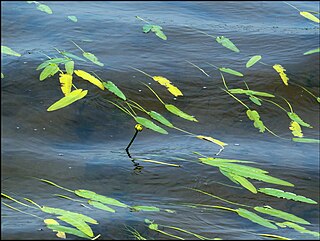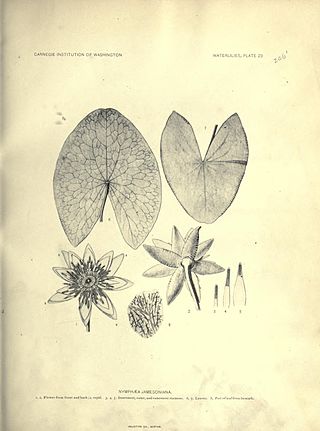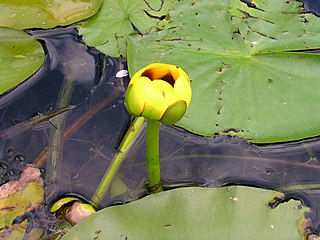
Nuphar is a genus of aquatic plants in the family Nymphaeaceae, with a temperate to subarctic Northern Hemisphere distribution. Common names include water-lily, pond-lily, alligator-bonnet or bonnet lily, and spatterdock.

Nuphar lutea, the yellow water-lily, brandy-bottle, or spadderdock, is an aquatic plant of the family Nymphaeaceae, native to northern temperate and some subtropical regions of Europe, northwest Africa, and western Asia. This species was used as a food source and in medicinal practices from prehistoric times with potential research and medical applications going forward.

Nymphaea mexicana is a species of aquatic plant that is native to the Southern United States and Mexico as far south as Michoacán. Common names include yellow water lily, Mexican water lily and banana water lily.

Nuphar variegata is a plant in the water lily family, Nymphaeaceae. It is native to much of Canada and the northernmost of the United States.

Nuphar polysepala is a species of Nuphar native to western North America. It is commonly found in shallow muddy ponds from northern Alaska and Yukon southward to central California and northern New Mexico, and can be recognized easily by its large floating leaves and bright yellow blossoms.

Nuphar sagittifolia, common name arrow-leaved water-lily or Cape Fear spatterdock, is a plant species known only from North Carolina, South Carolina, and Virginia.

Nymphaea jamesoniana is a species of waterlily native to the USA, Mexico, and tropical South America.
Nymphaea × thiona is a species of waterlily native to the US-American states Alabama, Florida, and Georgia. Additionally, it has been introduced to Costa Rica, as well as the US-American states Kentucky, and Nevada. It is a natural hybrid of Nymphaea mexicana and Nymphaea odorata.

Nymphaea gracilis is a species of waterlily endemic to Mexico. It is the only species of its genus which is endemic to Mexico.
Nymphaea guineensis is a species of waterlily native to the region spanning from tropical West Africa to Chad.
Nymphaea maculata is a species of waterlily native to tropical Africa.
Passiflora aurantioides is a species of passion flower native to the region from the Maluku Islands, Indonesia, to Papuasia and Queensland, Australia.
Barclaya motleyi is a species of perennial aquatic plant native to the region spanning from Thailand to Western Malesia, and New Guinea.
Nuphar ozarkana is a species of aquatic plant native to the US-American states Arkansas, Missouri, and Oklahoma.
Nuphar orbiculata is a species of rhizomatous aquatic plant native to the US-American states Alabama, Florida, and Georgia.

Nymphaea subg. Brachyceras is a subgenus of the genus Nymphaea.

Nuphar × rubrodisca is a species of rhizomatous aquatic plant native to Canada and the USA. It is a natural hybrid of Nuphar variegata and Nuphar microphylla.

Nymphaea pygmaea is a controversial species of perennial, aquatic herb in the family Nymphaeaceae native to Asia.

Nuphar pumila subsp. sinensis is a subspecies of Nuphar pumila native to China.

Nuphar sect. Astylus is a section within the genus Nuphar native to North America.













